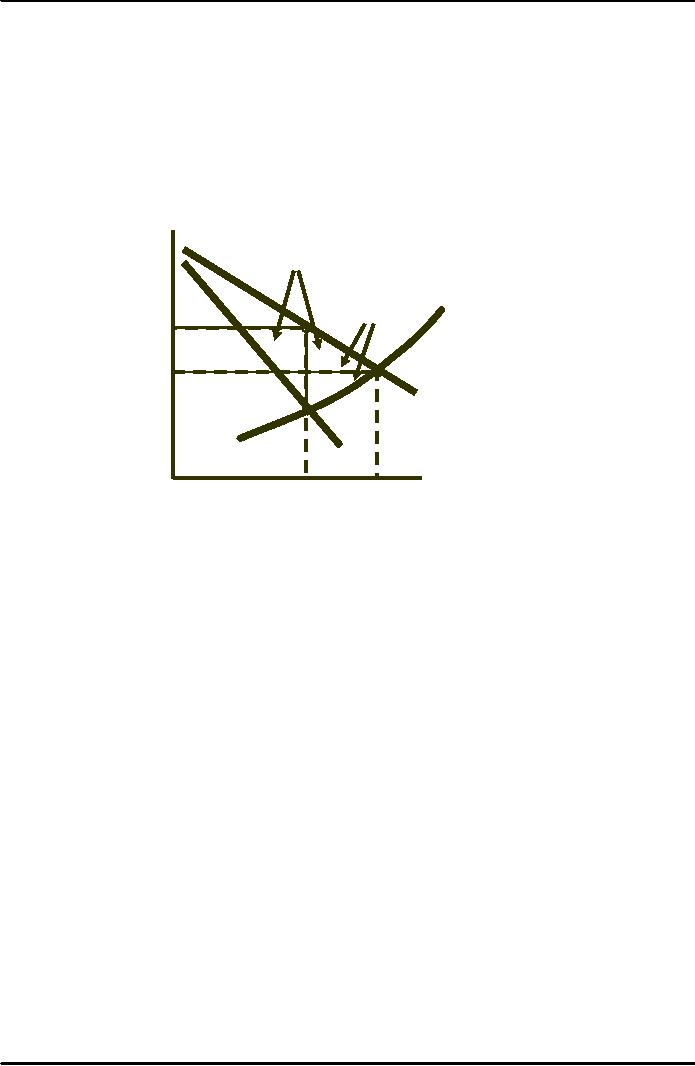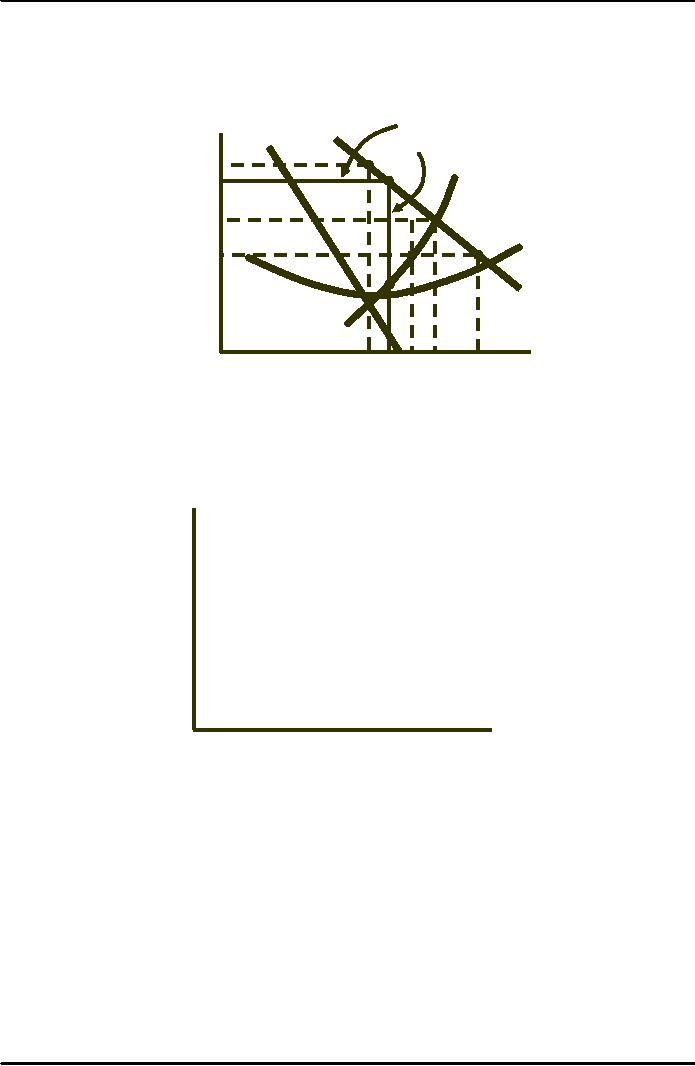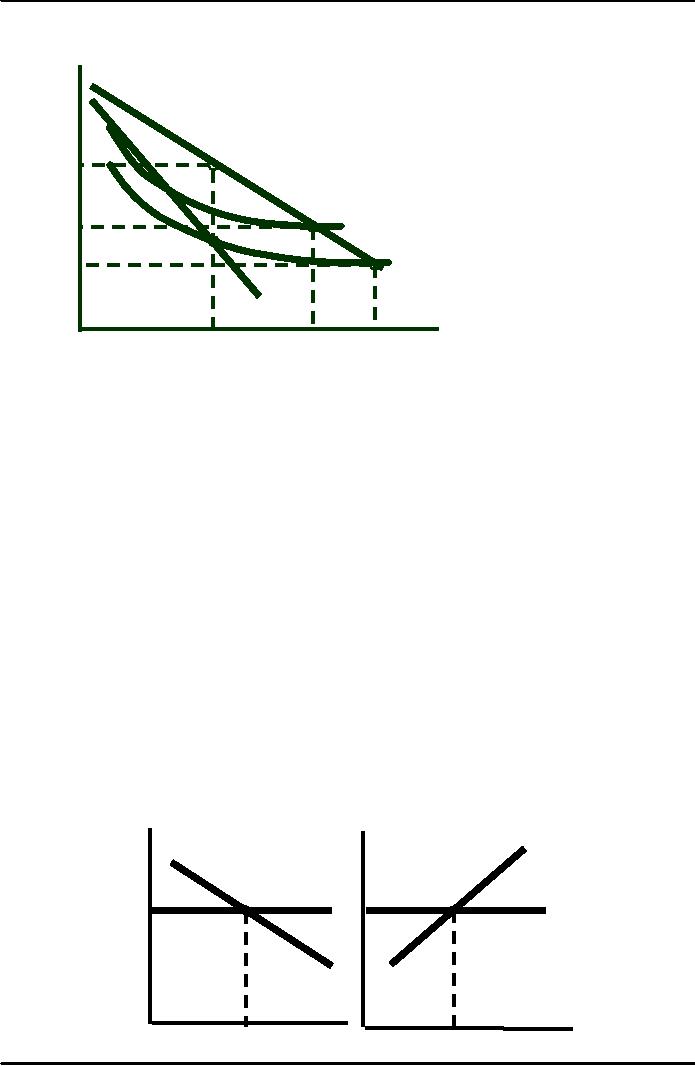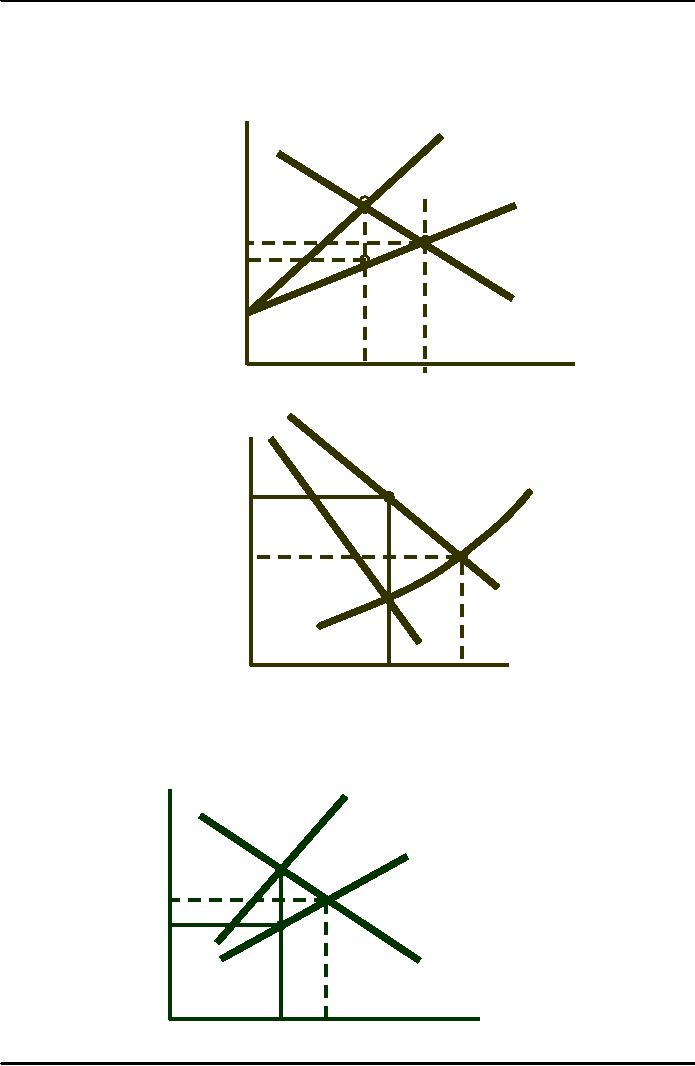 |

Microeconomics
ECO402
VU
Lesson
33
The
Social Costs of Monopoly
Power
Monopoly
power results in higher
prices and lower
quantities.
However,
does monopoly power make
consumers and producers in
the aggregate better
or
worse
off?
Deadweight
Loss from Monopoly
Power
Because
of the
Lost
Consumer
$/Q
higher
MC
rice,
consumers
p
lose
Deadweight
A+B
and
producer
Loss
Pm
gains
A-C.
A
B
PC
C
AR
MR
Quantity
QC
Qm
Rent
Seeking
Firms may
spend to gain monopoly
power
�
Lobbying
�
Advertising
�
Building
excess capacity
The
incentive to engage in monopoly
practices is determined by the
profit to be gained.
The
larger the transfer from
consumers to the firm, the
larger the social cost of
monopoly.
Price
Regulation
Recall that in
competitive markets, price
regulation created a deadweight
loss.
Question:
What about a
monopoly?
153

Microeconomics
ECO402
VU
Price
Regulation
Marginal
revenue curve
when
price is regulated
$/Q
to
be no higher that P1.
MR
MC
Pm
P1
P2 = PC
AC
P3
If
price is lowered to P3 output
decreases
and a shortage exists.
AR
If
left alone, a monopolist
Qm Q1
Q3
Q'3
Qc
Quantity
produces
Qm and charges
Pm.
Natural
Monopoly
A firm that
can produce the entire
output of an industry at a cost
lower than what it
would
be
if there were several
firms.
Regulating
the Price
of
a Natural Monopoly
$/Q
Natural
monopolies occur
because
of extensive
economies
of scale
Quantity
154

Microeconomics
ECO402
VU
Unregulated,
the monopolist
would
produce Qm and
$/Q
charge
Pm.
If
the price were regulate to
be PC,
the
firm would lose
money
and
go out of business.
Pm
Setting
the price at Pr
yields
the largest possible
output;excess
profit is zero.
AC
Pr
MC
PC
AR
MR
Qm
Qr
QC
Quantity
Regulation
in Practice
It is very
difficult to estimate the
firm's cost and demand
functions because they
change
with
evolving market
conditions
An alternative
pricing technique---rate-of-return
regulation allows the firms
to set a
maximum
price based on the expected
rate or return that the
firm will earn.
�
P = AVC + (D + T + sK)/Q,
where
P = price, AVC =
average variable cost
D = depreciation, T =
taxes
s = allowed
rate of return, K = firm's
capital stock
Monopsony
A
monopsony is a market in which
there is a single
buyer.
Monopsony
power is the ability of the
buyer to affect the price of
the good and pay
less than
the
price that would exist in a
competitive market.
Competitive
Buyer
Price
taker
P = Marginal
expenditure = Average
expenditure
D = Marginal
value
Competitive
Buyer: Compared to Competitive
Seller
Buyer
Seller
$/
$/Q
MC
Q
AR
= MR
ME
= AE
P*
P*
MR
= MC
P*
= MR
ME
= MV at
P*
= MC
Q*
D
= MV
ME
= P*
P*
= MV
Quantity
Quantity
Q*
Q*
155

Microeconomics
ECO402
VU
Monopsonist
Buyer
The
market supply curve is the
monopsonist's
average
expenditure curve
$/Q
ME
Monopsony
�ME
> P & above
S
S
= AE
PC
Competitiv
P*m
e
�P
= PC
MV
�Q
= QC
Q*m
QC
Quantity
Monopoly
$/Q
Note:
MR = MC;
AR
> MC; P > MC MC
P*
PC
AR
MR
QC
Quantity
Q*
Monopoly
and Monopsony
Monopsony
$/Q
ME
Note:
ME = MV;
ME
> AE; MV > P
S
= AE
PC
P*
MV
Q*
QC
Quantity
156

Microeconomics
ECO402
VU
Monopoly
Monopsony
MR
< P
ME
> P
P
> MC
P
< MV
Qm <
QC
Qm <
QC
P
m>
PC
Pm <
PC
157
Table of Contents:
- ECONOMICS:Themes of Microeconomics, Theories and Models
- Economics: Another Perspective, Factors of Production
- REAL VERSUS NOMINAL PRICES:SUPPLY AND DEMAND, The Demand Curve
- Changes in Market Equilibrium:Market for College Education
- Elasticities of supply and demand:The Demand for Gasoline
- Consumer Behavior:Consumer Preferences, Indifference curves
- CONSUMER PREFERENCES:Budget Constraints, Consumer Choice
- Note it is repeated:Consumer Preferences, Revealed Preferences
- MARGINAL UTILITY AND CONSUMER CHOICE:COST-OF-LIVING INDEXES
- Review of Consumer Equilibrium:INDIVIDUAL DEMAND, An Inferior Good
- Income & Substitution Effects:Determining the Market Demand Curve
- The Aggregate Demand For Wheat:NETWORK EXTERNALITIES
- Describing Risk:Unequal Probability Outcomes
- PREFERENCES TOWARD RISK:Risk Premium, Indifference Curve
- PREFERENCES TOWARD RISK:Reducing Risk, The Demand for Risky Assets
- The Technology of Production:Production Function for Food
- Production with Two Variable Inputs:Returns to Scale
- Measuring Cost: Which Costs Matter?:Cost in the Short Run
- A Firm’s Short-Run Costs ($):The Effect of Effluent Fees on Firms’ Input Choices
- Cost in the Long Run:Long-Run Cost with Economies & Diseconomies of Scale
- Production with Two Outputs--Economies of Scope:Cubic Cost Function
- Perfectly Competitive Markets:Choosing Output in Short Run
- A Competitive Firm Incurring Losses:Industry Supply in Short Run
- Elasticity of Market Supply:Producer Surplus for a Market
- Elasticity of Market Supply:Long-Run Competitive Equilibrium
- Elasticity of Market Supply:The Industry’s Long-Run Supply Curve
- Elasticity of Market Supply:Welfare loss if price is held below market-clearing level
- Price Supports:Supply Restrictions, Import Quotas and Tariffs
- The Sugar Quota:The Impact of a Tax or Subsidy, Subsidy
- Perfect Competition:Total, Marginal, and Average Revenue
- Perfect Competition:Effect of Excise Tax on Monopolist
- Monopoly:Elasticity of Demand and Price Markup, Sources of Monopoly Power
- The Social Costs of Monopoly Power:Price Regulation, Monopsony
- Monopsony Power:Pricing With Market Power, Capturing Consumer Surplus
- Monopsony Power:THE ECONOMICS OF COUPONS AND REBATES
- Airline Fares:Elasticities of Demand for Air Travel, The Two-Part Tariff
- Bundling:Consumption Decisions When Products are Bundled
- Bundling:Mixed Versus Pure Bundling, Effects of Advertising
- MONOPOLISTIC COMPETITION:Monopolistic Competition in the Market for Colas and Coffee
- OLIGOPOLY:Duopoly Example, Price Competition
- Competition Versus Collusion:The Prisoners’ Dilemma, Implications of the Prisoners
- COMPETITIVE FACTOR MARKETS:Marginal Revenue Product
- Competitive Factor Markets:The Demand for Jet Fuel
- Equilibrium in a Competitive Factor Market:Labor Market Equilibrium
- Factor Markets with Monopoly Power:Monopoly Power of Sellers of Labor